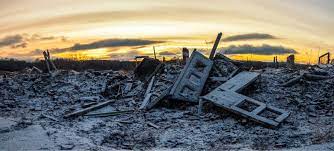
by Bill Schlesinger
And you tell me over and over and over again, my friend
Ah, you don’t believe we’re on the eve of destruction
P.F. Sloan, 1964
In these months after our withdrawal from Afghanistan, U.S. citizens may feel remote from foreign wars. But we should be far from sanguine. The world is filled with tense and nasty spots, which are only likely to fester with agricultural failures and depletion of freshwater from climate change. Think of India vs. Pakistan, Israel vs. Iran, and the two Koreas. Any of these long-standing animosities could flare up in an instant, and most of the players have access to nuclear weapons.
We may feel smug that we are not on the list, but it is unlikely that we can avoid participation if one of our long-time allies is in danger. Moreover, even a regional and limited nuclear exchange becomes a global problem through its effects on the atmosphere. The global transport of radioactivity from nuclear tests and from the Chernobyl meltdown is well documented. In the face of a limited exchange of nuclear weapons, it is only wishful thinking that we might avoid the health consequences of higher levels of radiation transported through the atmosphere.
Moreover, nearly 30 years ago, a prominent group of atmospheric scientists published a paper in Science cataloging the development of global wintertime conditions from the use of nuclear weapons in a massive exchange between the U.S. and (then) the Soviet Union. Mercifully, this has led to a reduction in warheads by these two superpowers, although plenty remain.
What concerns me here is the more likely probability a limited of exchange nuclear detonations in a regional hotspot. Toon et al. (2019) examined the potential impacts of such a conflict using a sophisticated model of atmospheric dynamics. Their results are sobering. For instance, a limited exchange between India and Pakistan is likely to inject black carbon into the stratosphere, reducing the sunlight on the Earth’s surface by 20 to 35% and global temperature by about 2 to 5 C for a decade. Although less certain, rainfall is projected to decrease 15 to 30%. Losses of the protective ozone layer from the stratosphere would subject the Earth’s surface to a 30 to 80% increase in ultraviolet radiation. The combined effects of lower temperatures and higher ultraviolet flux would reduce the productivity of the Earth’s land vegetation by 15 to 30% for 25 years. Such changes in plant growth are unthinkable in a world that already struggles to feed a population rising beyond 9 billion.
This is not the time to bask in isolationism. The circulation and behavior of the atmosphere connects our world, ensuring that what happens anywhere on Earth is felt everywhere. This pertains to rising emissions of carbon dioxide and catastrophic emissions of radiation and nuclear ash. It behooves peaceful nations of the world and all the people who live in them to encourage and participate in global governance to ensure our future.
NB This piece was originally inspired by a suggestion from Steve Hamilton (Cary Institute of Ecosystem Studies)
References:
Mills, M.J., O.B. Toon, J. Lee-Taylor and A. Robock. 2014. Multidecadal global cooling and unprecedented ozone loss following a regional nuclear conflict. Earth’s Future 2: doi: 10.1002/2013EF000205
Toon, O.B. and 9 others. 2019. Rapidly expanding nuclear arsenals in Pakistan and India portend regional and global catastrophe. Science Advances doi: 10.1126/sciadv.aay5478.
Turco, R.P., O.B. Toon, T.P. Ackerman, J.B. Pollack and C. Sagan. 1983. Nuclear winter: global consequences of multiple nuclear explosions. Science 222: 1283-1292.